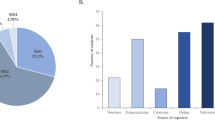Abstract
Background
In recent years, the medical curricula have become more crowded and the majority of medical students are no longer exposed to plastic surgery in medical school. Previous studies have revealed that most medical students are not aware of what the speciality entails.The aims of this paper were to describe the development of an elective course, as a method for including more plastic surgery in undergraduate medical training, and to investigate how many students were attracted to the course.
Methods
The course was designed to build on knowledge the students had acquired previously in their training. The aims and learning objectives were chosen so that they would be potentially useful to all future doctors and were described according to the SOLO taxonomy and the levels of Miller’s pyramid of learning were applied.
Results
The course attracted students who had not previously considered a career in plastic surgery. The number of students applying for the course exceeded the number of places on offer and the course was well received by the students taking it.
Conclusions
The course has the potential to increase the knowledge about plastic surgery among future doctors, possibly leading to improvements in both referrals and recruitment of suitable young doctors to the speciality.
Level of Evidence: Not ratable.
Similar content being viewed by others
References
Wade RG, Clarke EL, Leinster S et al (2013) Plastic surgery in the undergraduate curriculum: a nationwide survey of students, senior lecturers and consultant plastic surgeons in the UK. J Plast Reconstr Aesthet Surg 66(6):878–880
Rees-Lee JE, Lee S (2008) Reaching our successors: the trend for early specialisation and the potential effect on recruitment to our speciality. J Plast Reconstr Aesthet Surg 61:1135–1138
Dunkin CS, Pleat JM, Jones SA et al (2003) Perception and reality—a study of public and professional perceptions of plastic surgery. Br J Plast Surg 56:437–443
Al-Nuaimi Y, McGrouther G, Bayat A (2006) Modernizing medical careers in the UK and plastic surgery as a possible career choice: undergraduate opinions. J Plast Reconstr Aesthet Surg 59:1472–1474
Mahalingam S, Kalia P, Nagendran A et al (2014) Undergraduate exposure to plastic surgery: the medical student perspective. J Plast Reconstr Aesthet Surg 67:e125–e126
Austin RE, Wanzel KR (2015) Exposure to plastic surgery during undergraduate medical training: a single-institution review. Can J Plast Surg 23:43–47
Agarwal JP, Mendenhall SD, Moran LA et al (2013) Medical student perceptions of the scope of plastic and reconstructive surgery. Ann Plast Surg 70:343–349
Kling RE, Nayar HS, Harhay MO et al (2014) The scope of plastic surgery according to 2434 allopathic medical students in the United States. Plast Reconstr Surg 133:947–956
Parikh AR, Clarke A, Butler PE (2006) Plastic surgery and the undergraduate medical school curriculum. Med Educ 40:476–477
Park AJ, Scerri GV, Benamore R et al (1998) What do plastic surgeons do? J R Coll Surg Edinb 43:189–193
Tahiri Y, Lee J, Kanevsky J et al (2013) The differing perceptions of plastic surgery between potential applicants and current trainees: the importance of clinical exposure and electives for medical students. Can J Plast Surg 21:178–180
Khatib M, Soukup B, Boughton O et al (2015) Plastic surgery undergraduate training: how a single local event can inspire and educate medical students. Ann Plast Surg 75(2):208–212
McGoldrick C, Gordon D (2013) Does plastic surgery have an image problem?: the perception of plastic surgery in an era of general practitioner commissioning. J Plast Reconstr Aesthet Surg 66:1635–1636
Tanna N, Patel NJ, Azhar H et al (2010) Professional perceptions of plastic and reconstructive surgery: what primary care physicians think. Plast Reconstr Surg 126:643–650
Wade RG, Moses MA, Henderson J (2009) Teaching plastic surgery to undergraduates. J Plast Reconstr Aesthet Surg 62:267
Davis CR, O’Donoghue JM, McPhail J et al (2010) How to improve plastic surgery knowledge, skills and career interest in undergraduates in one day. J Plast Reconstr Aesthet Surg 63:1677–1681
Jalali M, Abood A, Flint LA et al (2010) Skills courses in plastic surgery: impact of enhancing confidence, skills and understanding amongst junior doctors. J Plast Reconstr Aesthet Surg 64:976–978
Vallino LD, Brown AS (1996) Assessing third-year medical students’ knowledge of and exposure to cleft palate before and after plastic surgery rotation. Ann Plast Surg 36:380–387
Greene AK, May JW Jr (2008) Applying to plastic surgery residency: factors associated with medical student career choice. Plast Reconstr Surg 121:1049–1053, discussion 54
Harden JR, Crosby MH, Davis M et al (1999) AMEE Guide No. 14: outcome-based education: part 5—from competency to meta-competency: a model for the specification of learning outcomes. Med Teach 21:546–552
Biggs JB, Tang CS-K (2007) Teaching for quality learning at university: what the student does. McGraw-Hill/Society for Research into Higher Education & Open University Press, Maidenhead
Ramsden P (2003) Learning to teach in higher education, 2nd edn. RoutledgeFalmer, London
Bowden JA, Marton F (2004) The university of learning: [beyond quality and competence]. Routledge, London
Buckley S, Coleman J, Khan K (2009) Best evidence on the educational effects of undergraduate portfolios. Clin Teach 7:187–191
Lonka K, Slotte V, Halttunen M et al (2001) Portfolios as a learning tool in obstetrics and gynaecology undergraduate training. Med Educ 35:1125–1130
Acknowledgments
We thank the students from the academic year 2012–2013 for taking our course and for their suggestions as to how our teaching could be improved.
Author information
Authors and Affiliations
Corresponding author
Ethics declarations
Ethical standards
The manuscript does not contain clinical studies or patient data.
Conflict of interest
Emma Hansson and Elisabeth Stövring-Nielsen declare that they have no conflict of interest.
Funding
This study was not funded.
Rights and permissions
About this article
Cite this article
Hansson, E., Stövring-Nielsen, E. Designing and arranging an undergraduate elective course in plastic surgery—the experiences of a Scandinavian department. Eur J Plast Surg 39, 207–212 (2016). https://doi.org/10.1007/s00238-015-1174-2
Received:
Accepted:
Published:
Issue Date:
DOI: https://doi.org/10.1007/s00238-015-1174-2




